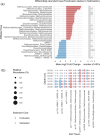Salinization alters microbial methane cycling in freshwater sediments
- PMID: 40528265
- PMCID: PMC12172229
- DOI: 10.1186/s40793-025-00739-w
Salinization alters microbial methane cycling in freshwater sediments
Abstract
Climate change-induced salinization poses a global threat to freshwater ecosystems and challenges microbial communities driving crucial biogeochemical processes, particularly methane cycling. This study examined the impact of salinization and the accompanying sulfate concentration increases on microbial community dynamics and methane cycling in coastal freshwater lake sediments. We show that sulfate enrichment in sediment profiles enables the proliferation of distinct sulfate-reducing bacteria (SRB) that reshape microbial niches by competing with methanogens and promoting sulfate-dependent anaerobic oxidation of methane (AOM). Freshwater SRB clusters, which compete with some methanogens for substrates but also degrade organic compounds into methanogenesis precursors, are replaced by the SEEP-SRB groups that form syntrophic relationships with ANME-1 in salinized sediments. As seawater intrudes and reshapes microbial communities, a methane pocket forms that escapes both aerobic and anaerobic oxidation. Underneath this methane pocket, SRB play a key role in enabling sulfate-dependent AOM, facilitating methane consumption at higher sediment depths. While all microorganisms demonstrated some physiological adaptability potential to elevated osmotic stress, SRB exhibited the highest resilience to increased salinity. These findings highlight how salinization-induced geochemical shifts, particularly sulfate enrichment, directly affect microbial community assembly and impact methane cycling in coastal freshwater ecosystems.
Keywords: Community shifts; Microbial adaptations; Microbial methane cycle; Salinization; Sulfate reducing bacteria.
© 2025. The Author(s).
Conflict of interest statement
Declarations. Ethics approval and consent to participate: Not applicable. Consent for publication: Not applicable. Competing interests: The authors declare no competing interests.
Figures




References
-
- Saunois M, et al. The global methane budget 2000–2017. Earth Syst Sci Data. 2020;12:1561–623.
-
- Bastviken D. Methane. Encyclopedia of inland waters. Academic; 2009. pp. 783–805.
-
- Praetzel LSE, et al. Organic matter and sediment properties determine in-lake variability of sediment CO2 and CH4 production and emissions of a small and shallow lake. Biogeosci. 2020;17:5057–78.
-
- Liu Y, Whitman BV. Metabolic, phylogenetic, and ecological diversity of the methanogenic archaea. Ann. N Y Acad Sci. 2008;1125:171–89. - PubMed
Grants and funding
LinkOut - more resources
Full Text Sources
Research Materials
